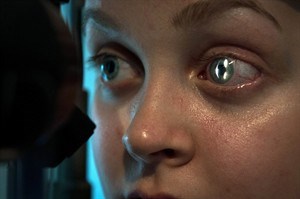
Abby Messner has her eye looked at by Dr. Asim Ali, staff surgeon in ophthalmology and vision sciences after undergoing surgery in 2012 that restored lost feeling in her eye by transplanting a nerve graft from her leg at The Hospital for Sick Children in Toronto, Wednesday, March 4, 2015. THE CANADIAN PRESS/Galit Rodan
Republished March 05, 2015 - 2:27 PM
Original Publication Date March 04, 2015 - 9:05 PM
TORONTO - Canadian pediatric surgeons have pioneered a technique to restore missing feeling in the eye — and prevent subsequent vision loss — using a nerve taken from a patient's leg and grafting it onto an existing healthy nerve in the face.
The minimally invasive operation brings sensation back to children born without feeling in one or both eyes, or to those who have lost feeling due to injury or surgery to remove a brain tumour.
Called corneal anaesthesia, the condition leaves patients unable to feel pain in an affected eye or recognize when it has been scratched or infected. Over time, such assaults on the eye can cause scarring and destroy vision.
"This has really been a problem without a good solution," said Dr. Asim Ali, an ophthalmologist who was part of a team at Toronto's Hospital for Sick Children that developed the procedure.
The first patient to have the surgery, Abby Messner, 18, of Stouffville, Ont., had lost feeling in her left eye after having a brain tumour removed at age 11. So began years of vigilance to protect her eye as best as she could.
"You really had to be conscientious with your surroundings," said Messner, a first-year student at the University of Guelph. "I wore sunglasses no matter what the weather was like outside, in case of things getting in my eye."
She gave up swimming because of chlorine in pools and stopped playing hockey for fear of a blow to her eye. Sleepovers at friends' homes or going with them into the bone-dry air of a mall were out of the question. She had to constantly lubricate her eye with drops and on occasion had her eye sewn either partially or fully shut to keep moisture in and dirt and other damaging substances out.
Ali said corneal anaesthesia is relatively rare — Sick Kids sees a handful of patients each year — but its effects are profound.
"Almost all of them will lose vision over time. Many of them will become legally blind due to scarring or recurrent episodes of infection."
Dr. Gregory Borschel, a plastic and reconstructive surgeon who developed the technique with Ali and fellow plastic surgeon Dr. Ronald Zuker, said a nerve-transplant surgery already existed in the medical literature. But doctors didn't embrace the highly invasive technique, which required an incision over the top of the head "from ear to ear" and involved "peeling down the face."
The Sick Kids' procedure, called a corneal neurotization, involves removing a leg nerve from below the knee and transplanting it above the eye on the side of the patient's face that still has feeling, then grafting it onto an existing nerve.
Surgeons then tunnel the grafted nerve under the skin across the forehead to the damaged cornea. Using an operating microscope, they separate the nerve ending into a web of component parts, called fascicles, and connect them around the damaged cornea.
"Then we wait," said Borschel. "Nerves take a long time to regenerate. At max, it's a millimetre a day. So what that means is about three months go by before the patients report feeling anything in the affected eye.
"And usually the first thing they notice is when they're putting in their drops. They start feeling the drops for the first time. But it doesn't feel like it's in their eye at first," he said, explaining the sensation appears to originate in the forehead region where surgeons tapped into the healthy nerve.
At about six months, he said, "something magical happens in the brain ... and they start feeling as if it's actually their eye they're putting the drops into and no longer their forehead."
For Messner, that initial sensation was confusing at first. "It was really sudden. I felt something in my right eye and it was actually in my left eye."
"I have full feeling, but it's a different kind of feeling. It's like my actual eyeball was numb and I have feeling in it now," she said, noting her eyelid and the skin around her eye are still without sensation, "but it's not that big of a deal."
While the surgery has meant getting back feeling in her eye, Messner will likely have a corneal transplant in a few months to restore her vision — repeated injuries and infections over the years have left a sight-stealing scar in the centre of her eye.
But being able to feel her eye and knowing she can protect it in the future has been life-changing. "I can do a lot more things now," including playing intramural soccer and living in residence at her southwestern Ontario university.
To date, the hospital has performed the operation on eight patients, including two adults, and is training surgeons from international centres in the technique.
Follow @SherylUbelacker on Twitter.
News from © The Canadian Press, 2015